Challenges and Recommendations for Leadtek's ERP System Implementation
VerifiedAdded on 2021/02/19
|10
|2993
|43
Report
AI Summary
This report provides an executive summary of the ERP system implementation within Leadtek Corporation, a technology-driven company. The report details the problems faced during the ERP implementation, including user difficulties, data inaccuracy, and delayed product deliveries, ultimately leading to the abandonment of the system. It analyzes the causes of these problems, such as inadequate employee training, lack of project scope definition, part-time team involvement, and insufficient system testing. Furthermore, the report suggests ways to avoid or mitigate these issues, including hiring expert consultants, creating customization and support services, improving time management, and establishing achievable schedules. The recommendations aim to ensure successful ERP implementation in future endeavors by Leadtek Corporation, emphasizing the importance of thorough planning, employee training, and system testing.
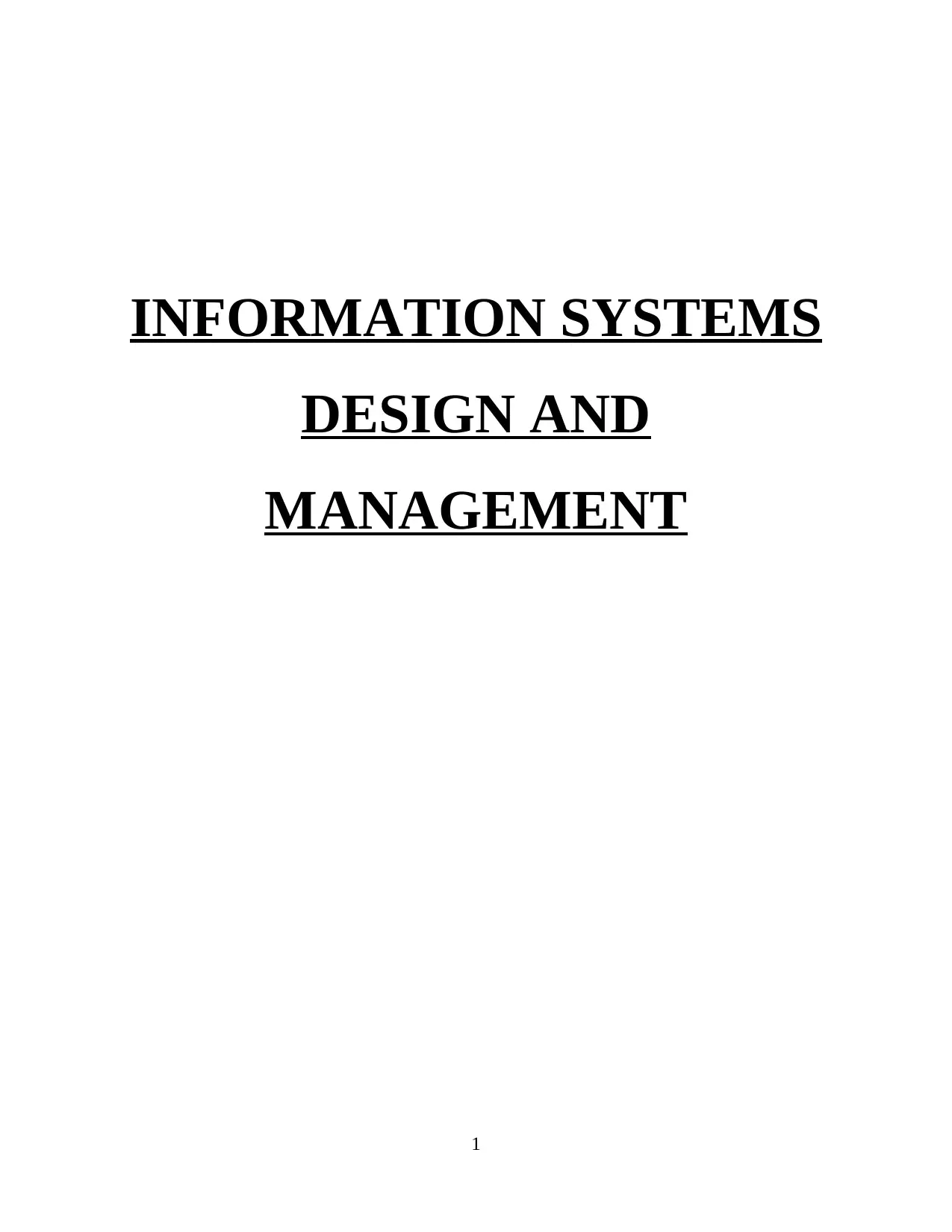
INFORMATION SYSTEMS
DESIGN AND
MANAGEMENT
1
DESIGN AND
MANAGEMENT
1
Paraphrase This Document
Need a fresh take? Get an instant paraphrase of this document with our AI Paraphraser
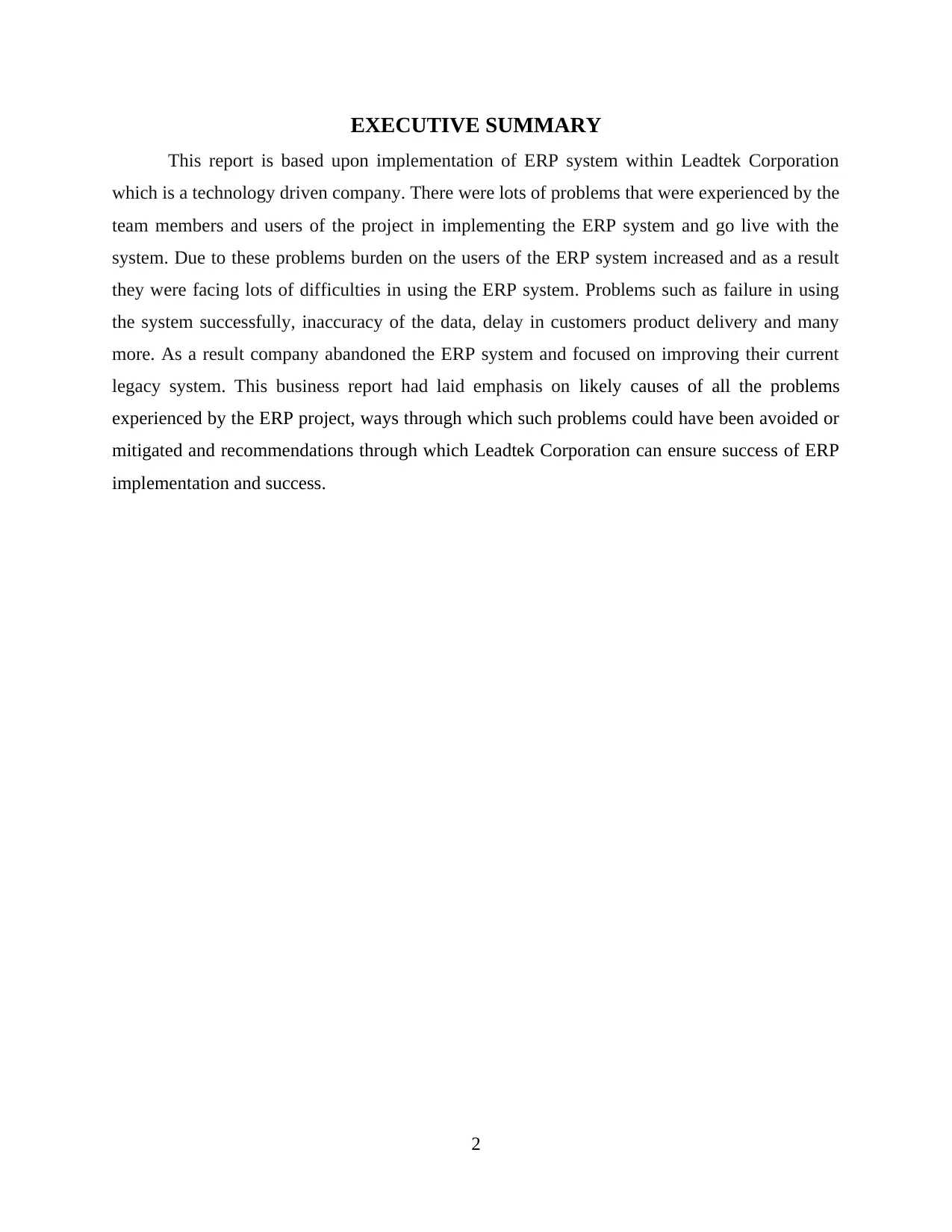
EXECUTIVE SUMMARY
This report is based upon implementation of ERP system within Leadtek Corporation
which is a technology driven company. There were lots of problems that were experienced by the
team members and users of the project in implementing the ERP system and go live with the
system. Due to these problems burden on the users of the ERP system increased and as a result
they were facing lots of difficulties in using the ERP system. Problems such as failure in using
the system successfully, inaccuracy of the data, delay in customers product delivery and many
more. As a result company abandoned the ERP system and focused on improving their current
legacy system. This business report had laid emphasis on likely causes of all the problems
experienced by the ERP project, ways through which such problems could have been avoided or
mitigated and recommendations through which Leadtek Corporation can ensure success of ERP
implementation and success.
2
This report is based upon implementation of ERP system within Leadtek Corporation
which is a technology driven company. There were lots of problems that were experienced by the
team members and users of the project in implementing the ERP system and go live with the
system. Due to these problems burden on the users of the ERP system increased and as a result
they were facing lots of difficulties in using the ERP system. Problems such as failure in using
the system successfully, inaccuracy of the data, delay in customers product delivery and many
more. As a result company abandoned the ERP system and focused on improving their current
legacy system. This business report had laid emphasis on likely causes of all the problems
experienced by the ERP project, ways through which such problems could have been avoided or
mitigated and recommendations through which Leadtek Corporation can ensure success of ERP
implementation and success.
2
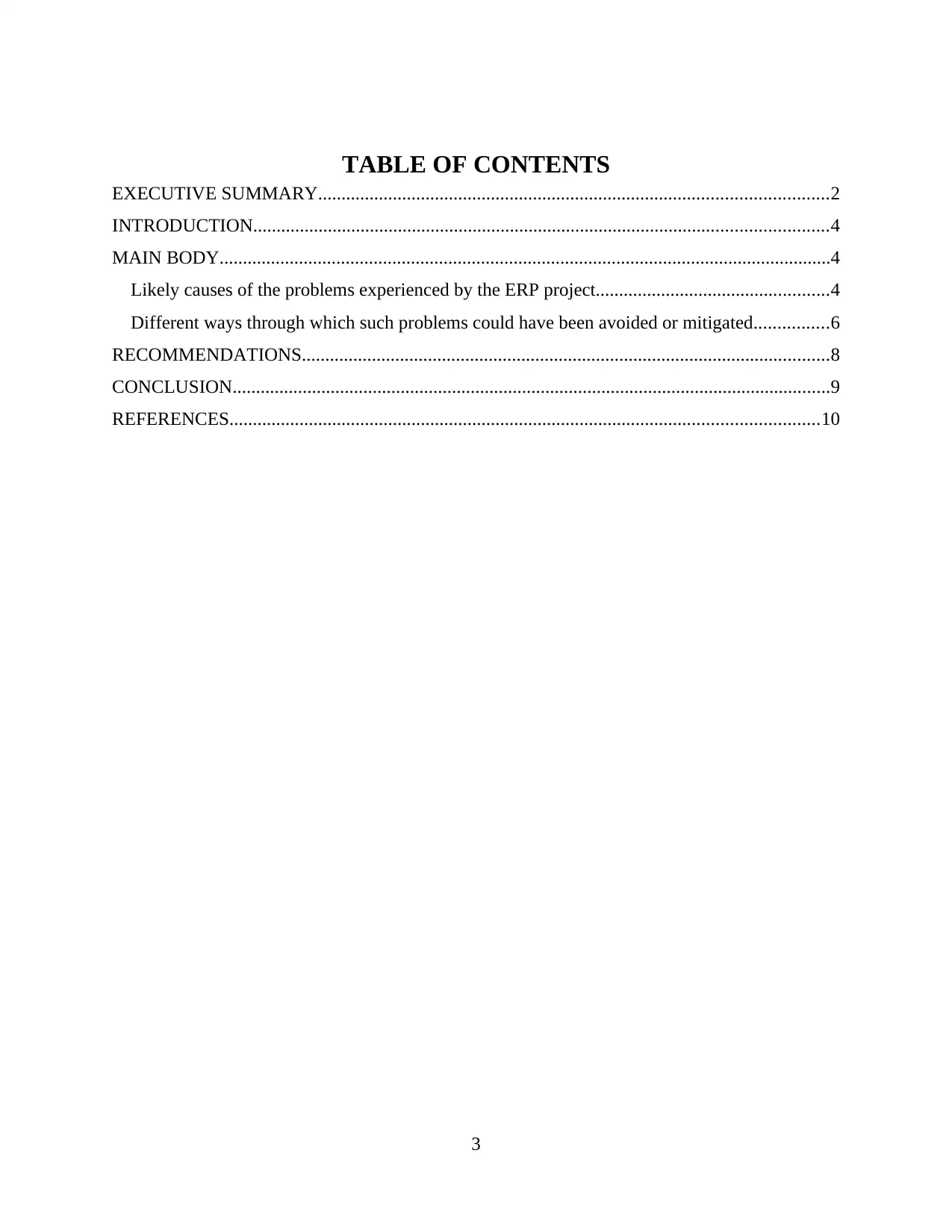
TABLE OF CONTENTS
EXECUTIVE SUMMARY.............................................................................................................2
INTRODUCTION...........................................................................................................................4
MAIN BODY...................................................................................................................................4
Likely causes of the problems experienced by the ERP project..................................................4
Different ways through which such problems could have been avoided or mitigated................6
RECOMMENDATIONS.................................................................................................................8
CONCLUSION................................................................................................................................9
REFERENCES..............................................................................................................................10
3
EXECUTIVE SUMMARY.............................................................................................................2
INTRODUCTION...........................................................................................................................4
MAIN BODY...................................................................................................................................4
Likely causes of the problems experienced by the ERP project..................................................4
Different ways through which such problems could have been avoided or mitigated................6
RECOMMENDATIONS.................................................................................................................8
CONCLUSION................................................................................................................................9
REFERENCES..............................................................................................................................10
3
⊘ This is a preview!⊘
Do you want full access?
Subscribe today to unlock all pages.

Trusted by 1+ million students worldwide
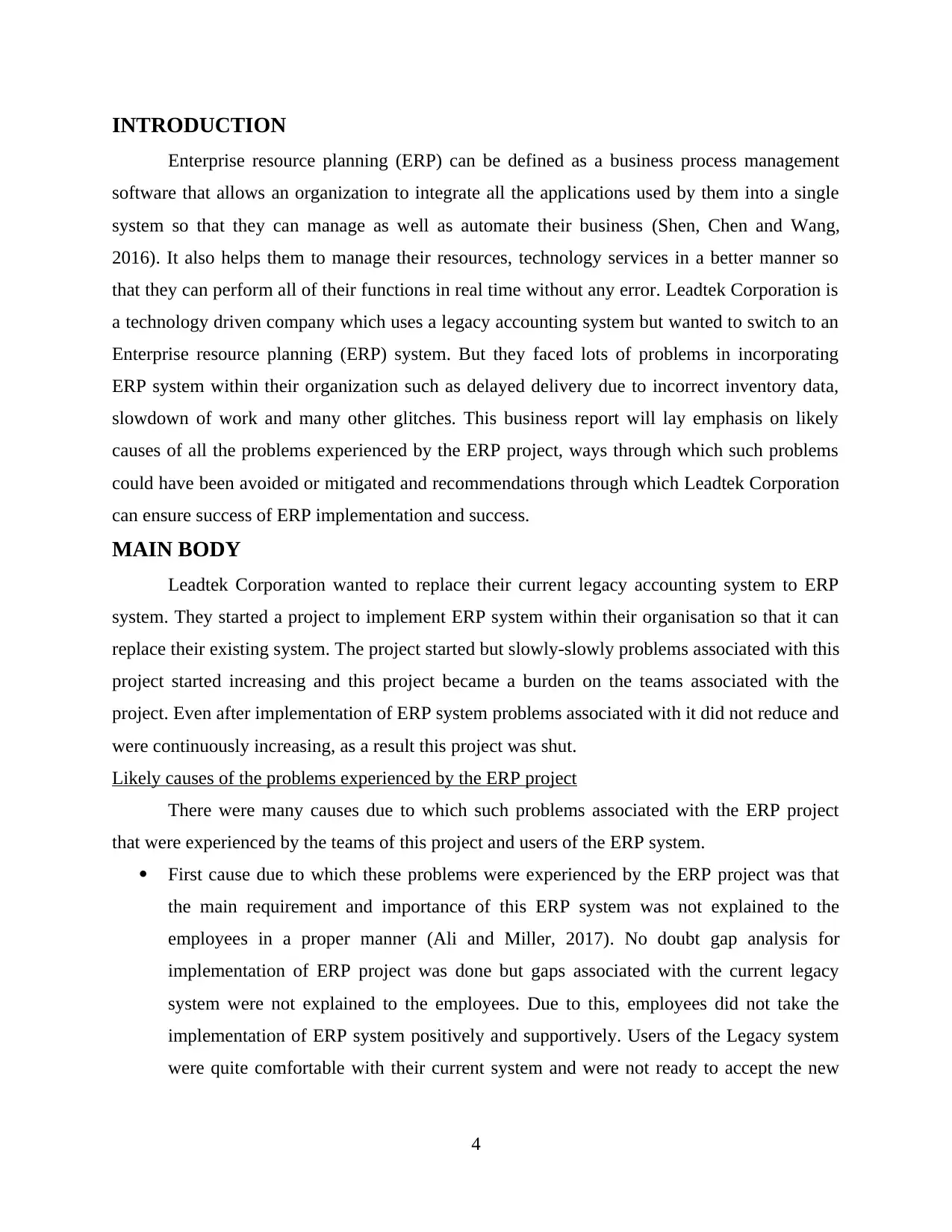
INTRODUCTION
Enterprise resource planning (ERP) can be defined as a business process management
software that allows an organization to integrate all the applications used by them into a single
system so that they can manage as well as automate their business (Shen, Chen and Wang,
2016). It also helps them to manage their resources, technology services in a better manner so
that they can perform all of their functions in real time without any error. Leadtek Corporation is
a technology driven company which uses a legacy accounting system but wanted to switch to an
Enterprise resource planning (ERP) system. But they faced lots of problems in incorporating
ERP system within their organization such as delayed delivery due to incorrect inventory data,
slowdown of work and many other glitches. This business report will lay emphasis on likely
causes of all the problems experienced by the ERP project, ways through which such problems
could have been avoided or mitigated and recommendations through which Leadtek Corporation
can ensure success of ERP implementation and success.
MAIN BODY
Leadtek Corporation wanted to replace their current legacy accounting system to ERP
system. They started a project to implement ERP system within their organisation so that it can
replace their existing system. The project started but slowly-slowly problems associated with this
project started increasing and this project became a burden on the teams associated with the
project. Even after implementation of ERP system problems associated with it did not reduce and
were continuously increasing, as a result this project was shut.
Likely causes of the problems experienced by the ERP project
There were many causes due to which such problems associated with the ERP project
that were experienced by the teams of this project and users of the ERP system.
First cause due to which these problems were experienced by the ERP project was that
the main requirement and importance of this ERP system was not explained to the
employees in a proper manner (Ali and Miller, 2017). No doubt gap analysis for
implementation of ERP project was done but gaps associated with the current legacy
system were not explained to the employees. Due to this, employees did not take the
implementation of ERP system positively and supportively. Users of the Legacy system
were quite comfortable with their current system and were not ready to accept the new
4
Enterprise resource planning (ERP) can be defined as a business process management
software that allows an organization to integrate all the applications used by them into a single
system so that they can manage as well as automate their business (Shen, Chen and Wang,
2016). It also helps them to manage their resources, technology services in a better manner so
that they can perform all of their functions in real time without any error. Leadtek Corporation is
a technology driven company which uses a legacy accounting system but wanted to switch to an
Enterprise resource planning (ERP) system. But they faced lots of problems in incorporating
ERP system within their organization such as delayed delivery due to incorrect inventory data,
slowdown of work and many other glitches. This business report will lay emphasis on likely
causes of all the problems experienced by the ERP project, ways through which such problems
could have been avoided or mitigated and recommendations through which Leadtek Corporation
can ensure success of ERP implementation and success.
MAIN BODY
Leadtek Corporation wanted to replace their current legacy accounting system to ERP
system. They started a project to implement ERP system within their organisation so that it can
replace their existing system. The project started but slowly-slowly problems associated with this
project started increasing and this project became a burden on the teams associated with the
project. Even after implementation of ERP system problems associated with it did not reduce and
were continuously increasing, as a result this project was shut.
Likely causes of the problems experienced by the ERP project
There were many causes due to which such problems associated with the ERP project
that were experienced by the teams of this project and users of the ERP system.
First cause due to which these problems were experienced by the ERP project was that
the main requirement and importance of this ERP system was not explained to the
employees in a proper manner (Ali and Miller, 2017). No doubt gap analysis for
implementation of ERP project was done but gaps associated with the current legacy
system were not explained to the employees. Due to this, employees did not take the
implementation of ERP system positively and supportively. Users of the Legacy system
were quite comfortable with their current system and were not ready to accept the new
4
Paraphrase This Document
Need a fresh take? Get an instant paraphrase of this document with our AI Paraphraser
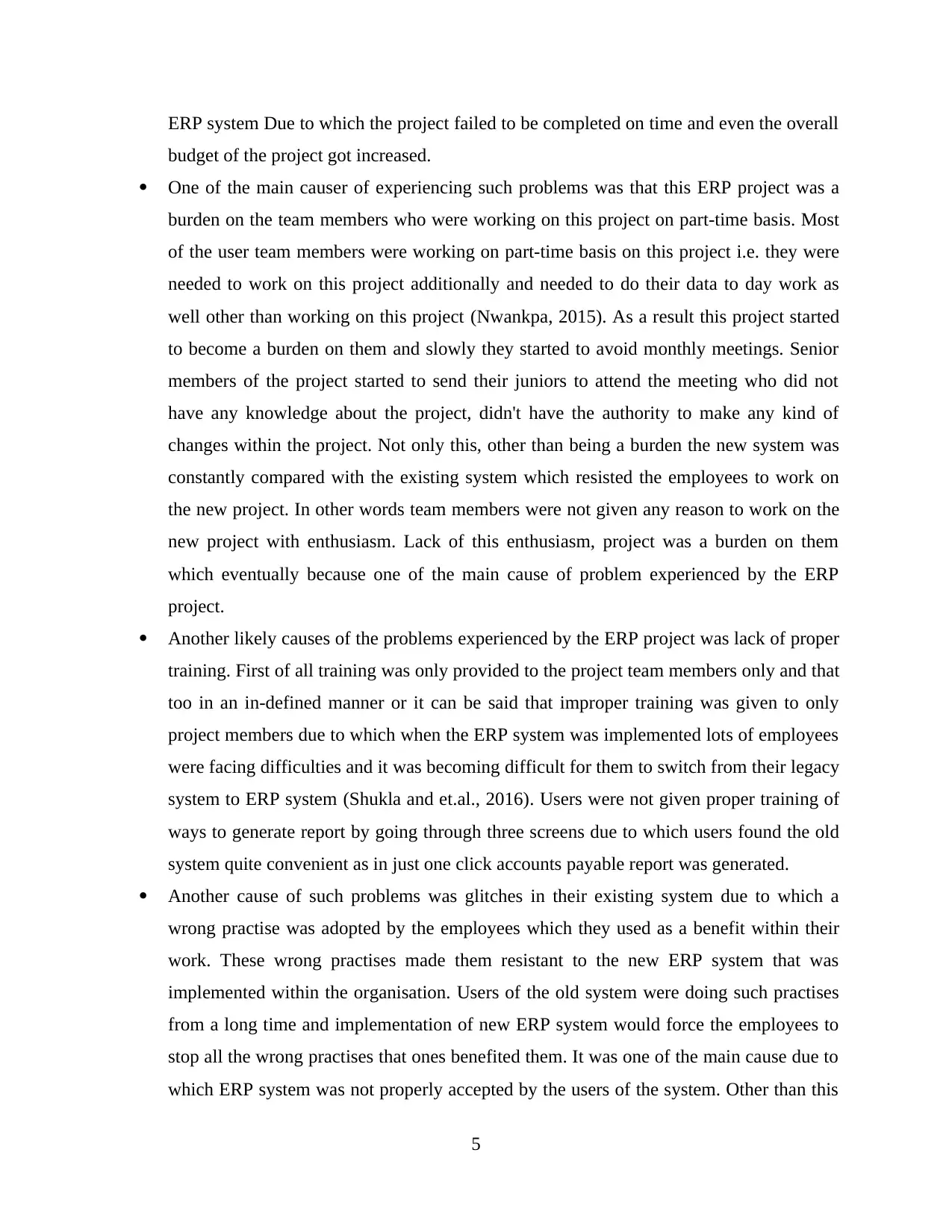
ERP system Due to which the project failed to be completed on time and even the overall
budget of the project got increased.
One of the main causer of experiencing such problems was that this ERP project was a
burden on the team members who were working on this project on part-time basis. Most
of the user team members were working on part-time basis on this project i.e. they were
needed to work on this project additionally and needed to do their data to day work as
well other than working on this project (Nwankpa, 2015). As a result this project started
to become a burden on them and slowly they started to avoid monthly meetings. Senior
members of the project started to send their juniors to attend the meeting who did not
have any knowledge about the project, didn't have the authority to make any kind of
changes within the project. Not only this, other than being a burden the new system was
constantly compared with the existing system which resisted the employees to work on
the new project. In other words team members were not given any reason to work on the
new project with enthusiasm. Lack of this enthusiasm, project was a burden on them
which eventually because one of the main cause of problem experienced by the ERP
project.
Another likely causes of the problems experienced by the ERP project was lack of proper
training. First of all training was only provided to the project team members only and that
too in an in-defined manner or it can be said that improper training was given to only
project members due to which when the ERP system was implemented lots of employees
were facing difficulties and it was becoming difficult for them to switch from their legacy
system to ERP system (Shukla and et.al., 2016). Users were not given proper training of
ways to generate report by going through three screens due to which users found the old
system quite convenient as in just one click accounts payable report was generated.
Another cause of such problems was glitches in their existing system due to which a
wrong practise was adopted by the employees which they used as a benefit within their
work. These wrong practises made them resistant to the new ERP system that was
implemented within the organisation. Users of the old system were doing such practises
from a long time and implementation of new ERP system would force the employees to
stop all the wrong practises that ones benefited them. It was one of the main cause due to
which ERP system was not properly accepted by the users of the system. Other than this
5
budget of the project got increased.
One of the main causer of experiencing such problems was that this ERP project was a
burden on the team members who were working on this project on part-time basis. Most
of the user team members were working on part-time basis on this project i.e. they were
needed to work on this project additionally and needed to do their data to day work as
well other than working on this project (Nwankpa, 2015). As a result this project started
to become a burden on them and slowly they started to avoid monthly meetings. Senior
members of the project started to send their juniors to attend the meeting who did not
have any knowledge about the project, didn't have the authority to make any kind of
changes within the project. Not only this, other than being a burden the new system was
constantly compared with the existing system which resisted the employees to work on
the new project. In other words team members were not given any reason to work on the
new project with enthusiasm. Lack of this enthusiasm, project was a burden on them
which eventually because one of the main cause of problem experienced by the ERP
project.
Another likely causes of the problems experienced by the ERP project was lack of proper
training. First of all training was only provided to the project team members only and that
too in an in-defined manner or it can be said that improper training was given to only
project members due to which when the ERP system was implemented lots of employees
were facing difficulties and it was becoming difficult for them to switch from their legacy
system to ERP system (Shukla and et.al., 2016). Users were not given proper training of
ways to generate report by going through three screens due to which users found the old
system quite convenient as in just one click accounts payable report was generated.
Another cause of such problems was glitches in their existing system due to which a
wrong practise was adopted by the employees which they used as a benefit within their
work. These wrong practises made them resistant to the new ERP system that was
implemented within the organisation. Users of the old system were doing such practises
from a long time and implementation of new ERP system would force the employees to
stop all the wrong practises that ones benefited them. It was one of the main cause due to
which ERP system was not properly accepted by the users of the system. Other than this
5
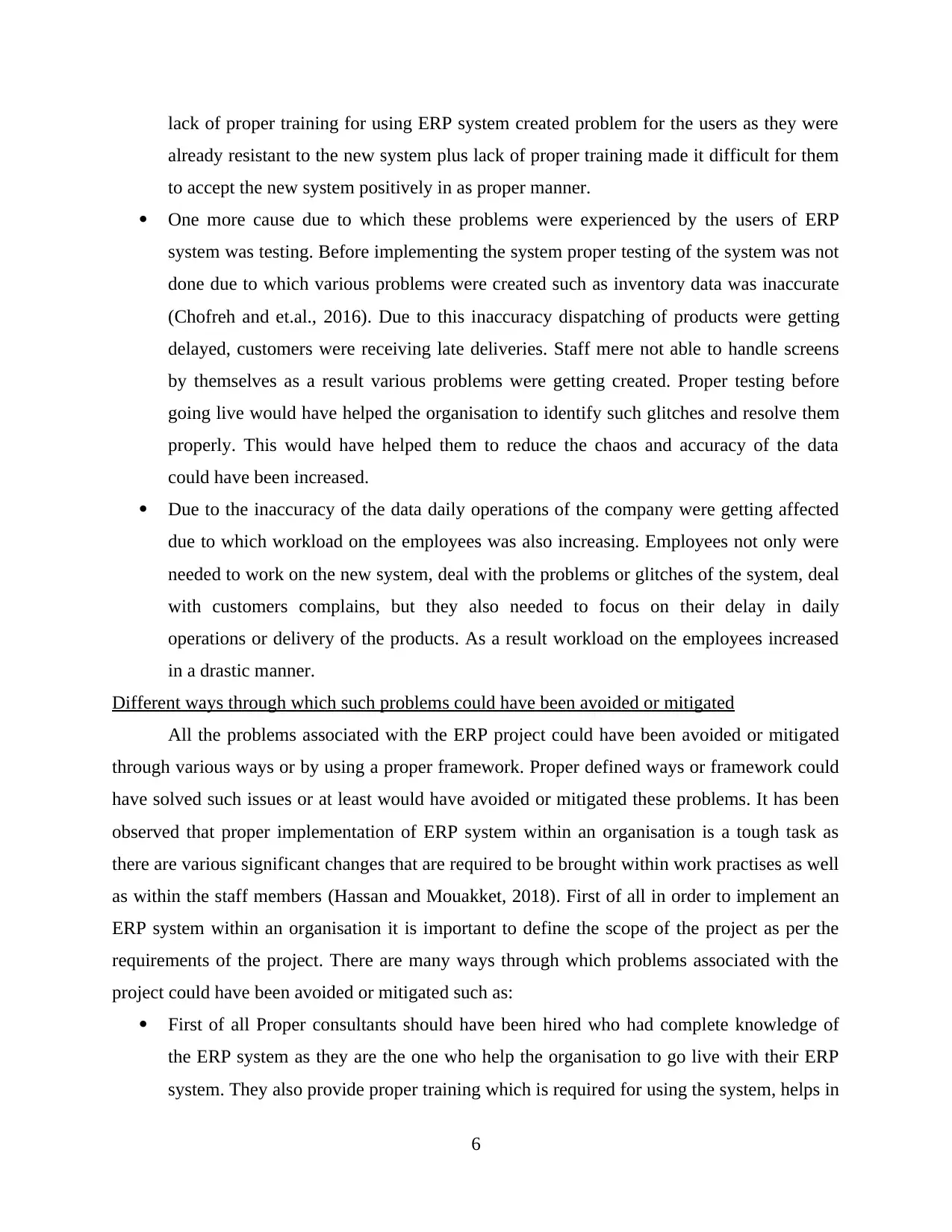
lack of proper training for using ERP system created problem for the users as they were
already resistant to the new system plus lack of proper training made it difficult for them
to accept the new system positively in as proper manner.
One more cause due to which these problems were experienced by the users of ERP
system was testing. Before implementing the system proper testing of the system was not
done due to which various problems were created such as inventory data was inaccurate
(Chofreh and et.al., 2016). Due to this inaccuracy dispatching of products were getting
delayed, customers were receiving late deliveries. Staff mere not able to handle screens
by themselves as a result various problems were getting created. Proper testing before
going live would have helped the organisation to identify such glitches and resolve them
properly. This would have helped them to reduce the chaos and accuracy of the data
could have been increased.
Due to the inaccuracy of the data daily operations of the company were getting affected
due to which workload on the employees was also increasing. Employees not only were
needed to work on the new system, deal with the problems or glitches of the system, deal
with customers complains, but they also needed to focus on their delay in daily
operations or delivery of the products. As a result workload on the employees increased
in a drastic manner.
Different ways through which such problems could have been avoided or mitigated
All the problems associated with the ERP project could have been avoided or mitigated
through various ways or by using a proper framework. Proper defined ways or framework could
have solved such issues or at least would have avoided or mitigated these problems. It has been
observed that proper implementation of ERP system within an organisation is a tough task as
there are various significant changes that are required to be brought within work practises as well
as within the staff members (Hassan and Mouakket, 2018). First of all in order to implement an
ERP system within an organisation it is important to define the scope of the project as per the
requirements of the project. There are many ways through which problems associated with the
project could have been avoided or mitigated such as:
First of all Proper consultants should have been hired who had complete knowledge of
the ERP system as they are the one who help the organisation to go live with their ERP
system. They also provide proper training which is required for using the system, helps in
6
already resistant to the new system plus lack of proper training made it difficult for them
to accept the new system positively in as proper manner.
One more cause due to which these problems were experienced by the users of ERP
system was testing. Before implementing the system proper testing of the system was not
done due to which various problems were created such as inventory data was inaccurate
(Chofreh and et.al., 2016). Due to this inaccuracy dispatching of products were getting
delayed, customers were receiving late deliveries. Staff mere not able to handle screens
by themselves as a result various problems were getting created. Proper testing before
going live would have helped the organisation to identify such glitches and resolve them
properly. This would have helped them to reduce the chaos and accuracy of the data
could have been increased.
Due to the inaccuracy of the data daily operations of the company were getting affected
due to which workload on the employees was also increasing. Employees not only were
needed to work on the new system, deal with the problems or glitches of the system, deal
with customers complains, but they also needed to focus on their delay in daily
operations or delivery of the products. As a result workload on the employees increased
in a drastic manner.
Different ways through which such problems could have been avoided or mitigated
All the problems associated with the ERP project could have been avoided or mitigated
through various ways or by using a proper framework. Proper defined ways or framework could
have solved such issues or at least would have avoided or mitigated these problems. It has been
observed that proper implementation of ERP system within an organisation is a tough task as
there are various significant changes that are required to be brought within work practises as well
as within the staff members (Hassan and Mouakket, 2018). First of all in order to implement an
ERP system within an organisation it is important to define the scope of the project as per the
requirements of the project. There are many ways through which problems associated with the
project could have been avoided or mitigated such as:
First of all Proper consultants should have been hired who had complete knowledge of
the ERP system as they are the one who help the organisation to go live with their ERP
system. They also provide proper training which is required for using the system, helps in
6
⊘ This is a preview!⊘
Do you want full access?
Subscribe today to unlock all pages.

Trusted by 1+ million students worldwide
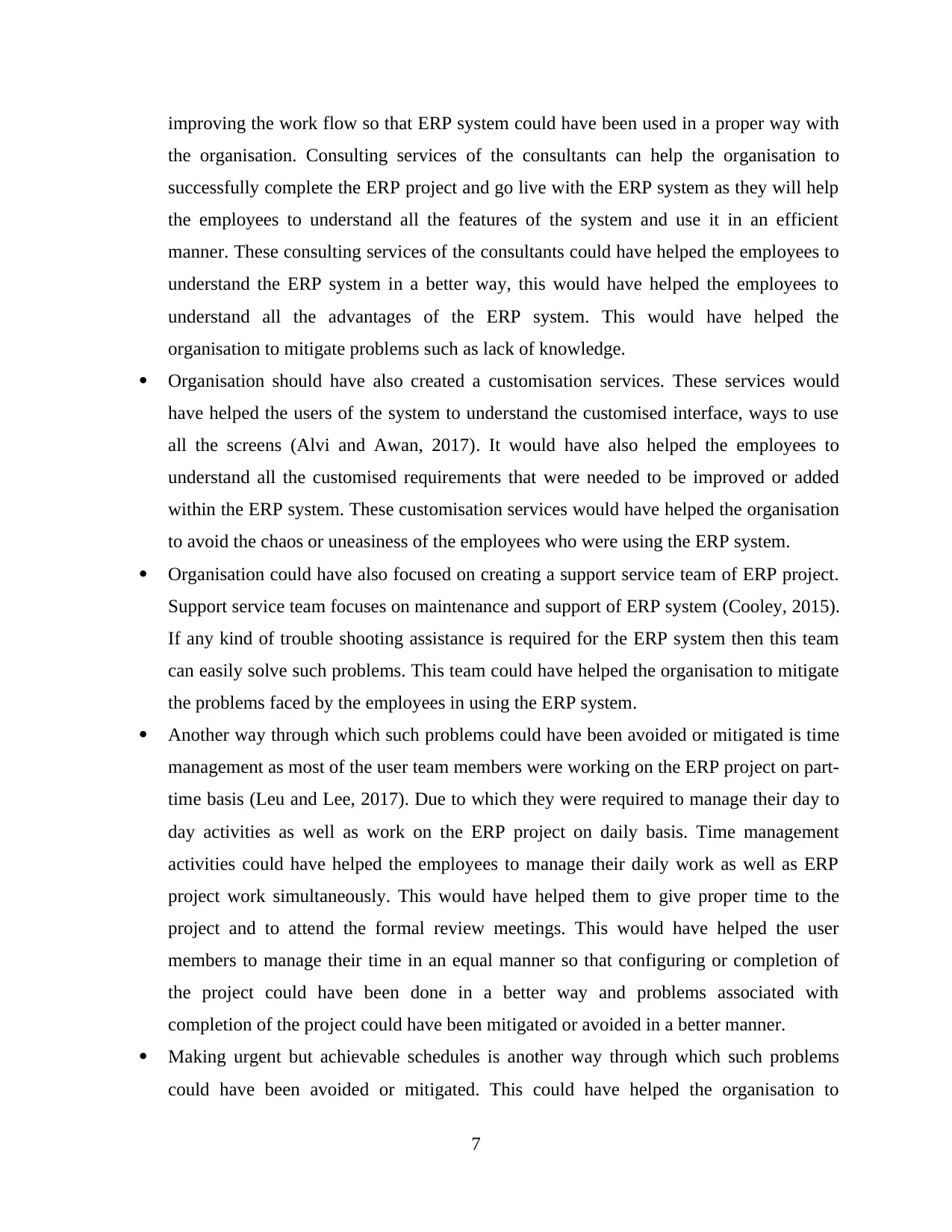
improving the work flow so that ERP system could have been used in a proper way with
the organisation. Consulting services of the consultants can help the organisation to
successfully complete the ERP project and go live with the ERP system as they will help
the employees to understand all the features of the system and use it in an efficient
manner. These consulting services of the consultants could have helped the employees to
understand the ERP system in a better way, this would have helped the employees to
understand all the advantages of the ERP system. This would have helped the
organisation to mitigate problems such as lack of knowledge.
Organisation should have also created a customisation services. These services would
have helped the users of the system to understand the customised interface, ways to use
all the screens (Alvi and Awan, 2017). It would have also helped the employees to
understand all the customised requirements that were needed to be improved or added
within the ERP system. These customisation services would have helped the organisation
to avoid the chaos or uneasiness of the employees who were using the ERP system.
Organisation could have also focused on creating a support service team of ERP project.
Support service team focuses on maintenance and support of ERP system (Cooley, 2015).
If any kind of trouble shooting assistance is required for the ERP system then this team
can easily solve such problems. This team could have helped the organisation to mitigate
the problems faced by the employees in using the ERP system.
Another way through which such problems could have been avoided or mitigated is time
management as most of the user team members were working on the ERP project on part-
time basis (Leu and Lee, 2017). Due to which they were required to manage their day to
day activities as well as work on the ERP project on daily basis. Time management
activities could have helped the employees to manage their daily work as well as ERP
project work simultaneously. This would have helped them to give proper time to the
project and to attend the formal review meetings. This would have helped the user
members to manage their time in an equal manner so that configuring or completion of
the project could have been done in a better way and problems associated with
completion of the project could have been mitigated or avoided in a better manner.
Making urgent but achievable schedules is another way through which such problems
could have been avoided or mitigated. This could have helped the organisation to
7
the organisation. Consulting services of the consultants can help the organisation to
successfully complete the ERP project and go live with the ERP system as they will help
the employees to understand all the features of the system and use it in an efficient
manner. These consulting services of the consultants could have helped the employees to
understand the ERP system in a better way, this would have helped the employees to
understand all the advantages of the ERP system. This would have helped the
organisation to mitigate problems such as lack of knowledge.
Organisation should have also created a customisation services. These services would
have helped the users of the system to understand the customised interface, ways to use
all the screens (Alvi and Awan, 2017). It would have also helped the employees to
understand all the customised requirements that were needed to be improved or added
within the ERP system. These customisation services would have helped the organisation
to avoid the chaos or uneasiness of the employees who were using the ERP system.
Organisation could have also focused on creating a support service team of ERP project.
Support service team focuses on maintenance and support of ERP system (Cooley, 2015).
If any kind of trouble shooting assistance is required for the ERP system then this team
can easily solve such problems. This team could have helped the organisation to mitigate
the problems faced by the employees in using the ERP system.
Another way through which such problems could have been avoided or mitigated is time
management as most of the user team members were working on the ERP project on part-
time basis (Leu and Lee, 2017). Due to which they were required to manage their day to
day activities as well as work on the ERP project on daily basis. Time management
activities could have helped the employees to manage their daily work as well as ERP
project work simultaneously. This would have helped them to give proper time to the
project and to attend the formal review meetings. This would have helped the user
members to manage their time in an equal manner so that configuring or completion of
the project could have been done in a better way and problems associated with
completion of the project could have been mitigated or avoided in a better manner.
Making urgent but achievable schedules is another way through which such problems
could have been avoided or mitigated. This could have helped the organisation to
7
Paraphrase This Document
Need a fresh take? Get an instant paraphrase of this document with our AI Paraphraser
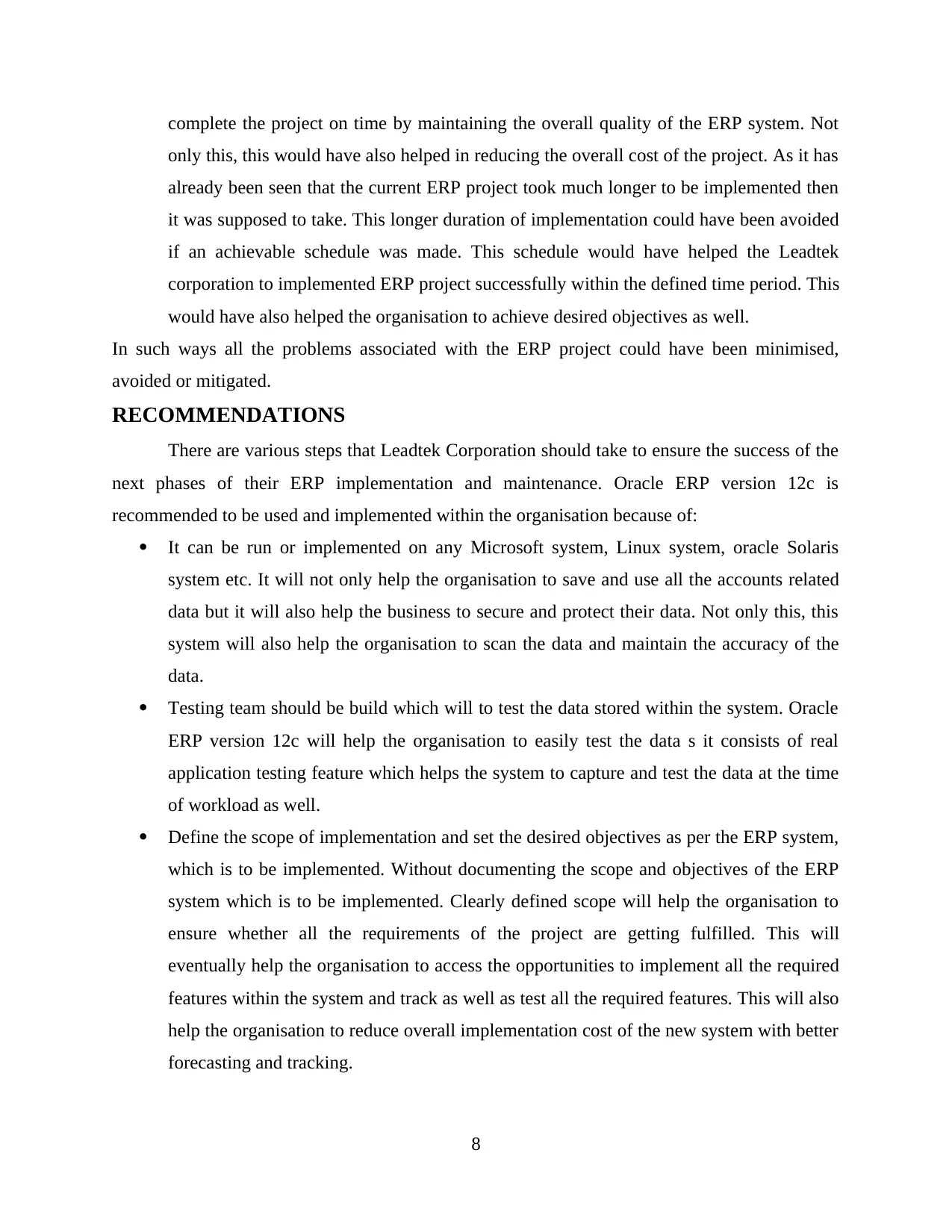
complete the project on time by maintaining the overall quality of the ERP system. Not
only this, this would have also helped in reducing the overall cost of the project. As it has
already been seen that the current ERP project took much longer to be implemented then
it was supposed to take. This longer duration of implementation could have been avoided
if an achievable schedule was made. This schedule would have helped the Leadtek
corporation to implemented ERP project successfully within the defined time period. This
would have also helped the organisation to achieve desired objectives as well.
In such ways all the problems associated with the ERP project could have been minimised,
avoided or mitigated.
RECOMMENDATIONS
There are various steps that Leadtek Corporation should take to ensure the success of the
next phases of their ERP implementation and maintenance. Oracle ERP version 12c is
recommended to be used and implemented within the organisation because of:
It can be run or implemented on any Microsoft system, Linux system, oracle Solaris
system etc. It will not only help the organisation to save and use all the accounts related
data but it will also help the business to secure and protect their data. Not only this, this
system will also help the organisation to scan the data and maintain the accuracy of the
data.
Testing team should be build which will to test the data stored within the system. Oracle
ERP version 12c will help the organisation to easily test the data s it consists of real
application testing feature which helps the system to capture and test the data at the time
of workload as well.
Define the scope of implementation and set the desired objectives as per the ERP system,
which is to be implemented. Without documenting the scope and objectives of the ERP
system which is to be implemented. Clearly defined scope will help the organisation to
ensure whether all the requirements of the project are getting fulfilled. This will
eventually help the organisation to access the opportunities to implement all the required
features within the system and track as well as test all the required features. This will also
help the organisation to reduce overall implementation cost of the new system with better
forecasting and tracking.
8
only this, this would have also helped in reducing the overall cost of the project. As it has
already been seen that the current ERP project took much longer to be implemented then
it was supposed to take. This longer duration of implementation could have been avoided
if an achievable schedule was made. This schedule would have helped the Leadtek
corporation to implemented ERP project successfully within the defined time period. This
would have also helped the organisation to achieve desired objectives as well.
In such ways all the problems associated with the ERP project could have been minimised,
avoided or mitigated.
RECOMMENDATIONS
There are various steps that Leadtek Corporation should take to ensure the success of the
next phases of their ERP implementation and maintenance. Oracle ERP version 12c is
recommended to be used and implemented within the organisation because of:
It can be run or implemented on any Microsoft system, Linux system, oracle Solaris
system etc. It will not only help the organisation to save and use all the accounts related
data but it will also help the business to secure and protect their data. Not only this, this
system will also help the organisation to scan the data and maintain the accuracy of the
data.
Testing team should be build which will to test the data stored within the system. Oracle
ERP version 12c will help the organisation to easily test the data s it consists of real
application testing feature which helps the system to capture and test the data at the time
of workload as well.
Define the scope of implementation and set the desired objectives as per the ERP system,
which is to be implemented. Without documenting the scope and objectives of the ERP
system which is to be implemented. Clearly defined scope will help the organisation to
ensure whether all the requirements of the project are getting fulfilled. This will
eventually help the organisation to access the opportunities to implement all the required
features within the system and track as well as test all the required features. This will also
help the organisation to reduce overall implementation cost of the new system with better
forecasting and tracking.
8
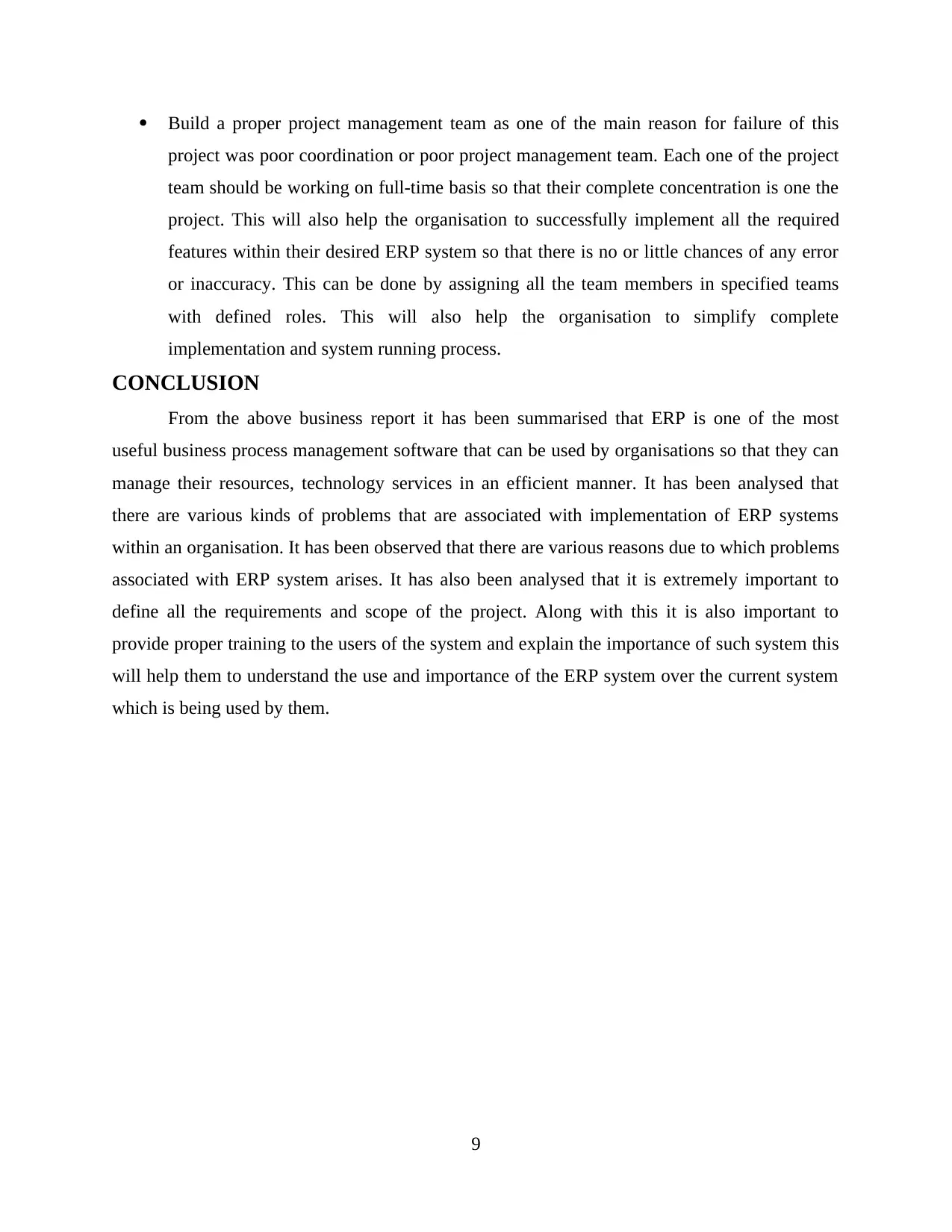
Build a proper project management team as one of the main reason for failure of this
project was poor coordination or poor project management team. Each one of the project
team should be working on full-time basis so that their complete concentration is one the
project. This will also help the organisation to successfully implement all the required
features within their desired ERP system so that there is no or little chances of any error
or inaccuracy. This can be done by assigning all the team members in specified teams
with defined roles. This will also help the organisation to simplify complete
implementation and system running process.
CONCLUSION
From the above business report it has been summarised that ERP is one of the most
useful business process management software that can be used by organisations so that they can
manage their resources, technology services in an efficient manner. It has been analysed that
there are various kinds of problems that are associated with implementation of ERP systems
within an organisation. It has been observed that there are various reasons due to which problems
associated with ERP system arises. It has also been analysed that it is extremely important to
define all the requirements and scope of the project. Along with this it is also important to
provide proper training to the users of the system and explain the importance of such system this
will help them to understand the use and importance of the ERP system over the current system
which is being used by them.
9
project was poor coordination or poor project management team. Each one of the project
team should be working on full-time basis so that their complete concentration is one the
project. This will also help the organisation to successfully implement all the required
features within their desired ERP system so that there is no or little chances of any error
or inaccuracy. This can be done by assigning all the team members in specified teams
with defined roles. This will also help the organisation to simplify complete
implementation and system running process.
CONCLUSION
From the above business report it has been summarised that ERP is one of the most
useful business process management software that can be used by organisations so that they can
manage their resources, technology services in an efficient manner. It has been analysed that
there are various kinds of problems that are associated with implementation of ERP systems
within an organisation. It has been observed that there are various reasons due to which problems
associated with ERP system arises. It has also been analysed that it is extremely important to
define all the requirements and scope of the project. Along with this it is also important to
provide proper training to the users of the system and explain the importance of such system this
will help them to understand the use and importance of the ERP system over the current system
which is being used by them.
9
⊘ This is a preview!⊘
Do you want full access?
Subscribe today to unlock all pages.

Trusted by 1+ million students worldwide
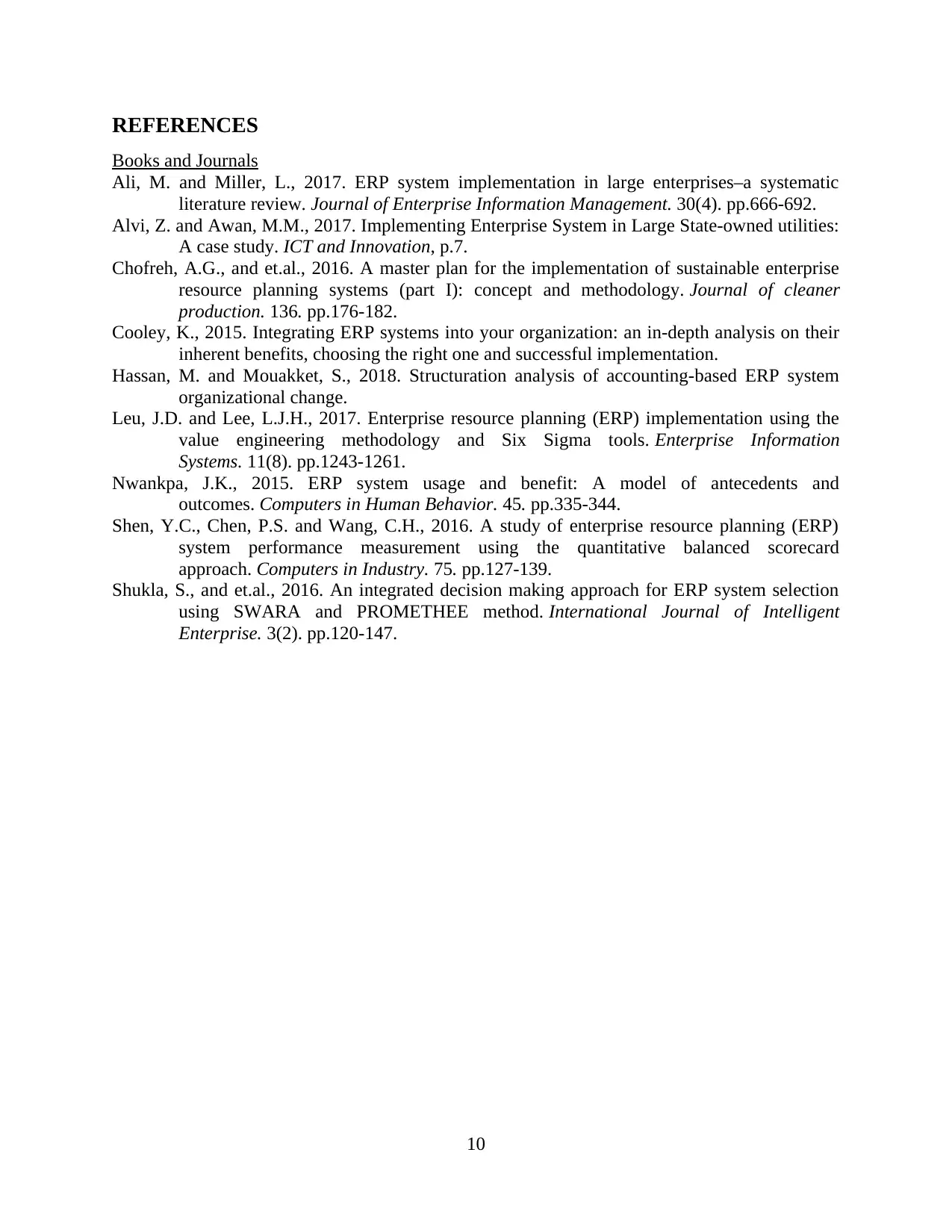
REFERENCES
Books and Journals
Ali, M. and Miller, L., 2017. ERP system implementation in large enterprises–a systematic
literature review. Journal of Enterprise Information Management. 30(4). pp.666-692.
Alvi, Z. and Awan, M.M., 2017. Implementing Enterprise System in Large State-owned utilities:
A case study. ICT and Innovation, p.7.
Chofreh, A.G., and et.al., 2016. A master plan for the implementation of sustainable enterprise
resource planning systems (part I): concept and methodology. Journal of cleaner
production. 136. pp.176-182.
Cooley, K., 2015. Integrating ERP systems into your organization: an in-depth analysis on their
inherent benefits, choosing the right one and successful implementation.
Hassan, M. and Mouakket, S., 2018. Structuration analysis of accounting-based ERP system
organizational change.
Leu, J.D. and Lee, L.J.H., 2017. Enterprise resource planning (ERP) implementation using the
value engineering methodology and Six Sigma tools. Enterprise Information
Systems. 11(8). pp.1243-1261.
Nwankpa, J.K., 2015. ERP system usage and benefit: A model of antecedents and
outcomes. Computers in Human Behavior. 45. pp.335-344.
Shen, Y.C., Chen, P.S. and Wang, C.H., 2016. A study of enterprise resource planning (ERP)
system performance measurement using the quantitative balanced scorecard
approach. Computers in Industry. 75. pp.127-139.
Shukla, S., and et.al., 2016. An integrated decision making approach for ERP system selection
using SWARA and PROMETHEE method. International Journal of Intelligent
Enterprise. 3(2). pp.120-147.
10
Books and Journals
Ali, M. and Miller, L., 2017. ERP system implementation in large enterprises–a systematic
literature review. Journal of Enterprise Information Management. 30(4). pp.666-692.
Alvi, Z. and Awan, M.M., 2017. Implementing Enterprise System in Large State-owned utilities:
A case study. ICT and Innovation, p.7.
Chofreh, A.G., and et.al., 2016. A master plan for the implementation of sustainable enterprise
resource planning systems (part I): concept and methodology. Journal of cleaner
production. 136. pp.176-182.
Cooley, K., 2015. Integrating ERP systems into your organization: an in-depth analysis on their
inherent benefits, choosing the right one and successful implementation.
Hassan, M. and Mouakket, S., 2018. Structuration analysis of accounting-based ERP system
organizational change.
Leu, J.D. and Lee, L.J.H., 2017. Enterprise resource planning (ERP) implementation using the
value engineering methodology and Six Sigma tools. Enterprise Information
Systems. 11(8). pp.1243-1261.
Nwankpa, J.K., 2015. ERP system usage and benefit: A model of antecedents and
outcomes. Computers in Human Behavior. 45. pp.335-344.
Shen, Y.C., Chen, P.S. and Wang, C.H., 2016. A study of enterprise resource planning (ERP)
system performance measurement using the quantitative balanced scorecard
approach. Computers in Industry. 75. pp.127-139.
Shukla, S., and et.al., 2016. An integrated decision making approach for ERP system selection
using SWARA and PROMETHEE method. International Journal of Intelligent
Enterprise. 3(2). pp.120-147.
10
1 out of 10
Related Documents
Your All-in-One AI-Powered Toolkit for Academic Success.
+13062052269
info@desklib.com
Available 24*7 on WhatsApp / Email
![[object Object]](/_next/static/media/star-bottom.7253800d.svg)
Unlock your academic potential
Copyright © 2020–2025 A2Z Services. All Rights Reserved. Developed and managed by ZUCOL.




